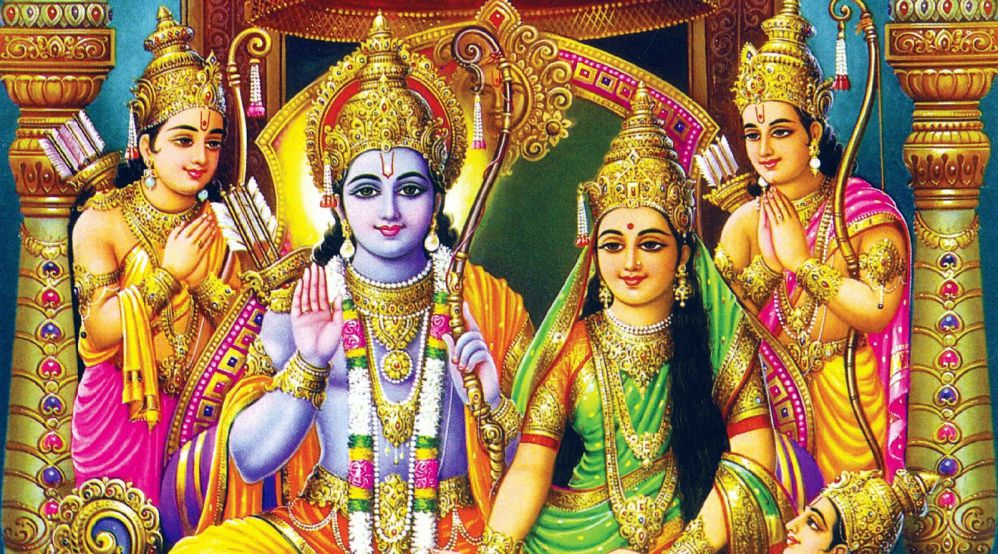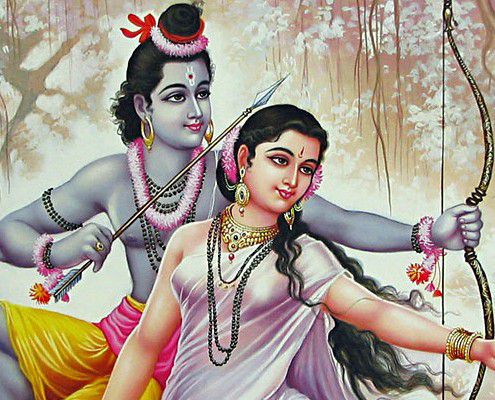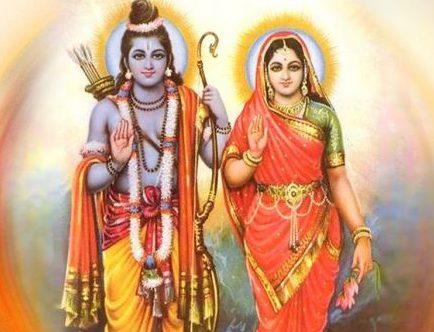No products in the cart.
The Ramayana, written and composed by Valmiki, is one of the greatest works of literature in the history of ancient India. It has survived the test of time, and still continues to be one of the most critically acclaimed works of all generations. It strikes a chord with everyone’s lives and touches their inner soul with subtle delicacy. It has proved to be a classic in the standards of world literature and has been translated in over 300 languages. Ramayana is also one of the largest ancient epics in word literature, divided into seven Kandas (books), comprising of about 500 sargas (chapters) and 24,000 verses. The characters in Ramayana stand to be inspirational figures in all our lives. Rama, Sita, Lakshmana and Hanuman epitomize all the virtues that should be ideally be present in all human beings in the planet to achieve the state of continual peace. In this article, we critically analyze the character of Goddess Sita, as presented by Valmiki in Ramayana.
Sita, symbolizes the meaning of an ideal woman, filled with loyalty for her husband. The meaning of her name is “furrow” that symbolizes the place where she was found by her father. When we hear of Sita, the first thing that strikes us is her unconditional bond of love with Lord Rama. In the face of extreme hardship, Lord Rama’s queen displays extraordinary character, founded on her pure devotion to the Lord. Rama, had to pass Shiva’s test of lifting and breaking a heavy bow, to win the right to marry Sita. Rama is the incarnation of Lord Vishnu, while Sita is the incarnation of Goddess Lakshmi, hence, they were born to be together connected by a string of eternal love. Sita embodies the character of an ideal woman to an ideal man, containing the right thoughts and actions.
Birth of Sita
The birth of Sita, is still a very controversial topic, open to debate amongst scholars. In Valmiki’s Ramayana, she was found in a furrow, as an abandoned child. This is the reason she is called the daughter of Mother Earth. However other potent theories that have been proposed about Sita’s birth are:
Sita as Vedavati
Vedavati was the daughter of sage Kushadhwaja, a learned scholar, living in hermitage deep inside the forests. Vedavati, who lives with her father, grows up to be a woman with ethereal beauty, and a fervent devotee of Lord Vishnu. She thus vows not to marry anyone except the Lord himself. One day, after her parents’ death, Ravana spots her and tries to proposition her. She denies as usual. Ravana, getting frustrated, tries to molest her by pulling her hair. She cuts off her hair, and cursed Ravana that she would jump in the fire and be reborn to become the cause of his destruction. She jumps into the fire, and enters it fearlessly. Legend has it that she was reborn as Sita, to cause the destruction of Ravana, and by being reborn as Sita, Vedavati also fulfills her dream of marrying Lord Vishnu, in the avatar of Rama.
Sita as Ravana’s Daughter
This theory about Sita being Ravana’s daughter is a very popular one. Ravana and his wife Mandodari were childless for many years after their marriage, and when Mandodari finally becomes pregnant, an astrology prediction states that the particular child will be the cause of his obliteration from the Earth. When this child was born, Ravana threw the child into a basket, however, that child was protected by Mother Earth, and was found by King Janaka. Thus, Ravana, while lusting for Sita, and tormenting and torturing her, never even imagined in his wildest dreams, that Sita was his own daughter. Thus he committed a greater sin, than just abducting Rama’s wife, he lusted for his own daughter, giving way to incest, which is a grave sin in Hindu mythologies. The astrology therefore proved to be right as Sita’s abduction and captivity was primarily responsible for Ravana’s obliteration from the face of Earth.
 Sita’s Unconditional Love for Rama
Sita’s Unconditional Love for Rama
When Rama was banished to the forests, for fourteen years, she willingly gave up her luxurious life at the kingdom to accompany Rama, as she believed that it was her duty to stay with her husband. Rama initially denied her, but she still persisted and accompanied him. She was so worried when Rama went alone in the forests, she sends Lakshmana to accompany him, thereby risking her life by staying alone. She successfully passed and endured the test of fire, agni pareeksha, clearing all doubts of Rama, regarding her purity, thereby also proving that she had been untouched by any other man, during her period of abduction by Ravana. At the end of the story, she again proved her purity, however this time, she vanished inside the earth, from where she had originated.
Sita’s Inner Harmony and Peace with Nature
In Valmiki’s Ramayana, Sita’s origin is depicted to be from Mother Earth itself. Thus, Sita is a part of Nature, and is shown to always be in harmony and at peace with Nature. When Rama was denying her not to accompany him to the forests, she said that she would remain happy merely by gazing at the hills, lakes and rivers. This exhibited her immense love and oneness with Mother Earth and all its natural elements. Throughout the Ramayana she has been referred to as “golden-skinned” and “doe-eyed”. The golden deer symbolizes an image of beauty and forest wildness.
The natural and scenic beauty of the forests give Sita a sense of pleasure and inner peace. The serenity of the forests makes her feel delighted and so cheerful that she would choose the simplicities of the forest life over the complexities of the life at the kingdom. She never at once regretted sacrificing the comforts of palatial life, as her inner frequencies were seamlessly in a sync with the frequencies of the forests, animals, lakes, trees, birds and rivers. Sita had a special connection with these elements of the earth. In Ramayana, when the couple is first crossing the Ganga, Sita prays to Goddess Ganga to protect Sri Rama from all the hardships of forest life. When Ravana abducts her, she calls out to all these elements of the natural world to come and rescue her. She calls upon the rivers, the animals, the trees, desperately begging to save her from the hands of the evil Ravana. The trees wept in the form of sap, as they couldn’t help Sita. Even the animals were heartbroken to see her being captured by the cruel devil. While she was being abducted, it seemed like the entire Earth went into a trance of poignancy. In all her attempts to ask Nature for help, she wakes an old vulture, Jatayu who dies fighting Ravana and drops her jewels to some monkeys, who later helped Rama in finding Sita.
Ravana tries to win over Sita in Lanka, by claiming that he loves her. However, Sita mocks Ravana by calling him a “duck meandering on the shore”, while referring to herself as a graceful swan, who will not be swayed by a crass duck. At Lanka, during her dialogues with Ravana, she is portrayed to be a fearless woman, who can fight for her moral values and devotion to her husband, and the doubts of her being a submissive and weak woman is absolutely erased. This enraged Ravana, and he gave Sita twelve months to change her mind, and sends her to a grove of ashoka trees, where she was tortured by cruel and filthy women. Inspite of all this bad treatment, Sita was calm both outside and inside. Her soul was still in absolute harmony, and this harmony with nature gave her the tolerance and resistance to face the terror of Ravana and his fellow demons. She constantly tells Ravana to give up even shimmer of hope that she would give in to him, as his intentions were evil and actions perverse, and that she is inseparable from Rama as sunlight is from the Sun. Her unequivocal devotion for Rama had been derived from her oneness, harmony, inner peace and stability with Nature. Nature gave her the strength to tolerate her stay at Lanka. Nature gave her the self-belief that Rama would vanquish Ravana and rescue her from that unholy kingdom, replete with devils, filled with cruel intentions.
It is this inner harmony that breeds other good qualities of Sita. We see her extreme forgiveness, when she pardons all the female guards, when Hanuman offered to kill them. She understood that what they did was a consequence of Ravana’s orders. She is also very generous, when it comes to gratitude. She willingly gifts Hanuman the necklace that Rama gave her, as a token of appreciation of all the help that that he and his army provided to Rama to rescue her back. Her generosity is also highlighted when she asks the wives of all the monkey warriors to accompany them back to Ayodhya, to participate in the grand celebrations there with them.








